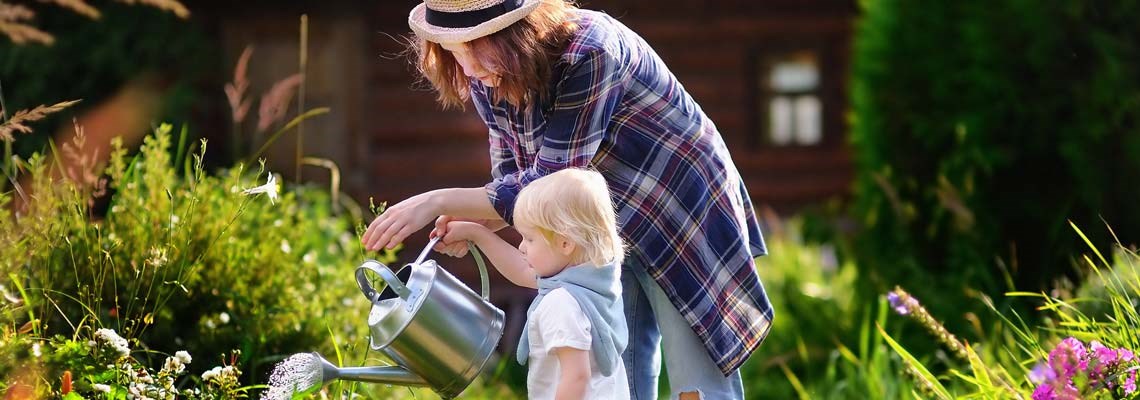Gardening: things to do in March
As you say goodbye to winter, it’s time to get outside and rediscover your green fingers for the new season. Do a little prep and planting now and your garden will look great when it’s flourishing in spring and summer.

What garden prep should I do?
After you've given your garden an all-round pre-spring clean, you'll want to spend some time taking care of your soil, grass and shrubs.
Look after your soil
Start by removing any weeds from your lawn and flowerbeds before they take hold to prevent them from intruding again. There are different ways to kill weeds, including natural home methods or sprays you can buy at your local garden centre.
Then rake away dead leaves and twigs from your lawn, so that the grass can absorb sunlight. The most environmentally friendly way to get rid of leaves is to compost, which can then be used to add nutrients to your soil and turned into plant food.
If you don't already know, you can find out how to compost here: https://www.rhs.org.uk/advice/profile?PID=444
Trim the lawn and cut hedges
March is pruning time for many plants. You should cut back hedges and overgrown shrubs before new growth comes through, making clearing away dead stems difficult. It's important to carefully prune and shape their branches and stems, so they grow back stronger and improve flowering.
Learn how to prune your plants here: http://www.gardenersworld.com/how-to/grow-plants/how-to-prune-your-plants/
Take care of your lawnmower
Now is also a great time to start maintenance on your mower, before things get busy in your garden during spring. Looking after your lawnmower will ensure you get the cleanest cut and make mowing the grass easier. The exact process will vary depending on the kind of lawnmower you own. However, when you come to read the manual, you'll find there are three main areas you will likely focus on:
- Changing oil – dirt and grime can collect in the oil, which could damage your engine. To change the oil, simply follow the instructions in the manual of your lawnmower.
- Replacing or cleaning the spark plug – if the plug is still in good condition you will only need to clean it, yet many people prefer to replace it every year.
- Replacing or cleaning the air filter – most filters can be cleaned with water and detergent solution. If they become too clogged and dirty they will need to be replaced. How you do this will depend on the type of filter.
Learn more about how you can carry out all three points in this handy video:
What can I plant this month?
As part of standard upkeep, you will also want to replace or sharpen the blade. This should be done prior to your first cut of the year. Lawnmower blades require a little more effort than other maintenance. You can do this by either carefully following the manual or your nearest mower service centre will be able to assist you.
With the days getting longer, the sun shining stronger and the risk of frost now behind us, garden seeds can start to be sown. A handful of spring bulbs, like daffodils, should already be starting to bloom in your garden and brighten your surroundings.
Make a plan
Before you reach for your tools, map out which areas of your garden and flowerbeds are most ideal for your plant. For example, if your garden has a lot of shade, make sure you choose shade-tolerant plants for these spots and that taller plants don't block the sun from shorter ones. It's also a handy idea to check the dates of any new purchases, so you know when to get planting!
Grow fruit and vegetables
There are lots of vegetable seeds that can be sown in March. Peppers and tomatoes will benefit from being planted earlier to give them a long growing season. Fast-growing veg like peas and salad leaves can be started off early too, ready for you to harvest in late spring and early summer.
When purchasing seeds, check if they should be planted in pots in a greenhouse or sown directly into the ground. For example, cauliflowers will need to be sown under cover, yet beetroot and carrots can be grown outdoors.
Plant summer bulbs
Different months are better for different plants and shrubs. For example, if you'd like to plant bare-root roses, March is your last chance. You may find that the seeds of some summer plants can be sown now to give them a head start. Outside, you can begin to plant lilies, gladioli, crocosmia, and agapanthus – simply plant them in the ground and wait for them to blossom around August time. Dahlias can also be grown now, yet these should be in pots and under cover.